Participating in sports is fundamental to youth development, teaching valuable lessons in teamwork, discipline, and physical fitness. However, the playing field is also common for injuries, including those to the mouth and teeth. Dental trauma in athletics can lead to serious oral health issues, affecting an athlete’s ability to compete and their long-term dental health and quality of life. Awareness and prevention of such injuries are crucial.
Keep reading this article to learn what every athlete should know about preventing dental trauma.
Importance of Dental Safety in Sports
Sports activities—whether at an amateur or professional level—pose significant risks for oral injuries. These injuries can range from broken teeth and jaw injuries to more severe cases involving long-term dental problems. Protecting athletes’ oral health requires more than occasional reminders to wear mouthguards; it involves a comprehensive understanding of risk and implementing effective preventive measures.
However, if you’re a young athlete’s parent looking to understand and implement these protective practices, checking out educational resources on how to protect your child’s smile would be invaluable. Such resources guide the best practices for safeguarding athletes’ smiles during sports activities.
Common Types of Dental Injuries in Sports
Athletes can experience various forms of dental trauma, including:
- Tooth Fractures: These are cracks or breaks in the teeth caused by a direct hit or fall.
- Avulsed Teeth: This refers to a complete displacement of a tooth from its socket following an impact.
- Luxated Teeth: This involves displacing a tooth that remains in the socket but in a wrong alignment.
- Soft Tissue Injuries: These are lacerations and bruises to the gums, lips, and cheeks.
Understanding these common injuries can help plan appropriate response strategies and preventive measures.
The Role of Protective Gear in Preventing Dental Injuries
The most effective way to prevent dental injuries in sports is using protective gear. Mouthguards, especially, are crucial. They cushion blows that might otherwise cause broken teeth and injuries to the lips, tongue, face, or jaw. They typically cover the upper teeth, as they are more likely to be injured than the lower ones.
Furthermore, there are three main types of mouthguards, which include:
- Stock Mouthguards: These are pre-formed and ready to wear, though often bulky and poorly fit.
- Boil and Bite Mouthguards: Made from thermoplastic material, they offer a better fit than stock mouthguards after being softened in hot water and molded to the teeth.
- Custom-Fitted Mouthguards: Made by a dentist from a mold of the athlete’s teeth, they provide the best protection and comfort but at a higher cost.
While any mouthguard is better than none, custom-fitted ones can significantly reduce the risk of sports-related dental injuries and are recommended for serious athletes.
Best Practices for Dental Health in Athletes
Regular dental check-ups are essential for athletes, as routine examinations can identify and mitigate potential dental issues before they escalate into serious problems. These check-ups allow dentists to monitor oral health, assess the condition of any existing dental work, and provide guidance on the best practices for dental care in sports.
Immediate response to dental injuries is also crucial in sports. Athletes and coaches should know how to handle these emergencies to save teeth. For instance, if a tooth is avulsed (knocked out), it should be kept moist—ideally in milk, saliva, or a saline solution—and the injured individual should visit a dentist as soon as possible. Proper handling can increase the chances of successfully reimplanting the tooth.
On the other hand, hydration and nutrition also play a significant role in maintaining oral health. Athletes should consider the following:
- Avoid sugary sports drinks and snacks that can promote tooth decay.
- Opt for water to maintain hydration without increasing the risk of cavities.
- Choose healthy snacks, such as fruits, vegetables, and nuts, which are better for teeth and overall health.
Adhering to these practices can protect athletes’ dental health, ensuring they remain competitive and healthy.
Creating a Safe Sporting Environment
Educational programs are essential in teaching athletes about dental health and injury prevention. These programs should focus on:
- The consequences of dental injuries can help athletes understand the long-term impact of oral injuries;
- Instruction on proper use of mouthguards, helmets, and face protection;
- Emphasizing the importance of regular brushing and flossing, especially for athletes wearing braces or other dental appliances.
On the other hand, enforcing safety rules is crucial to ensure that all athletes wear appropriate protective gear during practices and games. Coaches and team managers should routinely check that:
- Mouthguards are always worn and mandatory during both practices and competitive play.
- Protective gear fits properly. Conduct regular checks to ensure that helmets and face guards protect and fit correctly.
Additionally, emergency preparedness is vital for handling dental emergencies during sporting events. Sports organizations should have clear plans that include:
- Immediate care protocols: These include guidelines on what to do in the event of a dental injury.
- Access to dental emergency contacts: These involve quick referral systems to nearby dental practitioners or emergency services.
- First aid training: This ensures coaches and trainers have the skills to manage initial dental trauma care.
By implementing these measures, sports programs can create a safer environment that minimizes dental risks for athletes.
Conclusion
Dental trauma in sports is a serious concern that requires attention and proactive prevention strategies. By keeping the information mentioned above in mind, athletes can minimize their risk of dental injuries. Ensuring that sports remain a positive experience for youth involves protecting their health on all fronts, including their valuable smiles.

